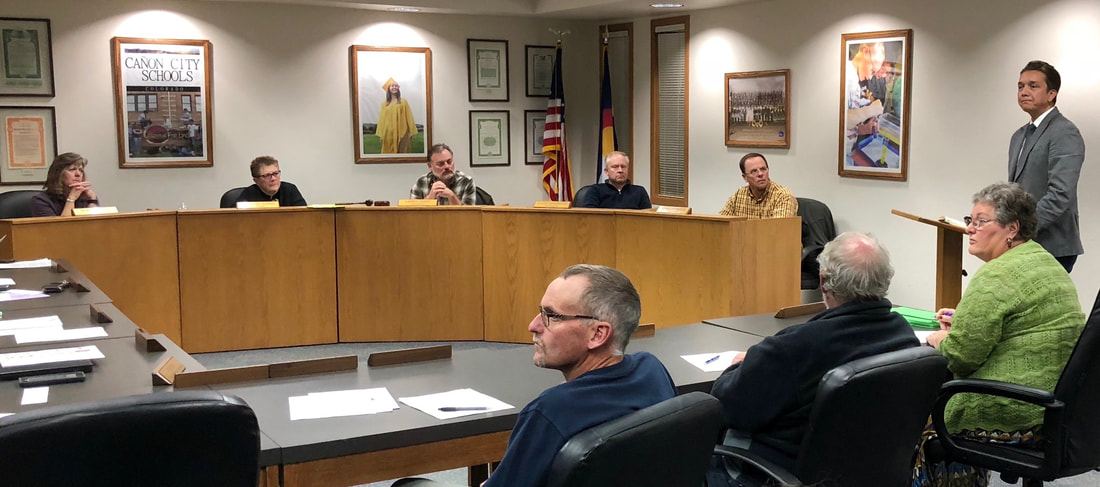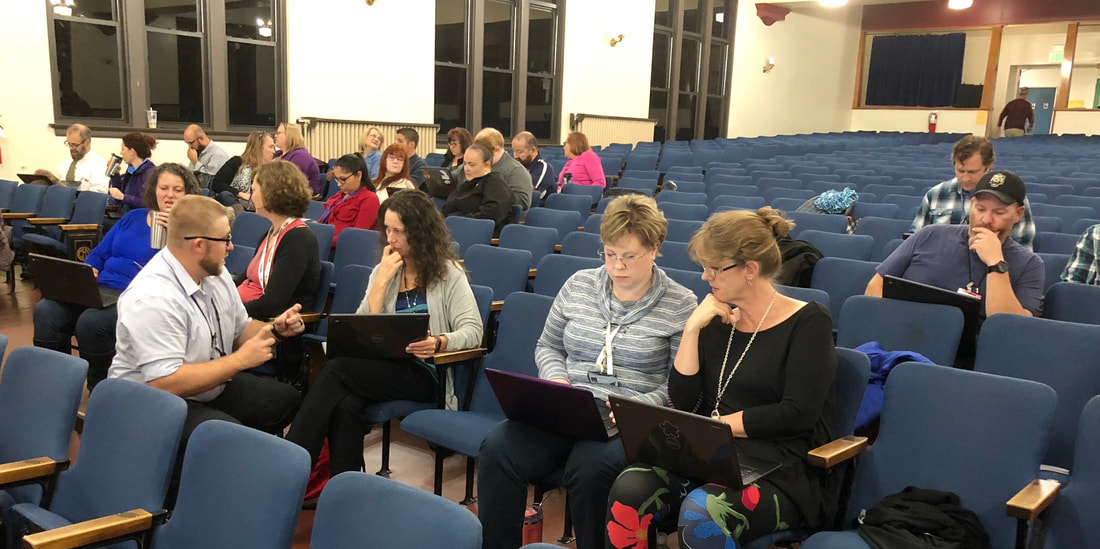Echoes from Cañon
Our Board Adopted Core Beliefs
1. We meet the social-emotional needs of all students, putting Maslow’s Hierarchy of Needs before Bloom’s Taxonomy.
2. We believe learning growth matters most, requires risk-taking, and the work we do in our schools has the greatest impact on this.
3. We’re future-focused, believing the development of certain traits and skills will best prepare our students for ever-changing careers.
4. We emphasize what is good for kids over the needs and comfort of adults.
1. We meet the social-emotional needs of all students, putting Maslow’s Hierarchy of Needs before Bloom’s Taxonomy.
2. We believe learning growth matters most, requires risk-taking, and the work we do in our schools has the greatest impact on this.
3. We’re future-focused, believing the development of certain traits and skills will best prepare our students for ever-changing careers.
4. We emphasize what is good for kids over the needs and comfort of adults.
Our Core Beliefs in Action
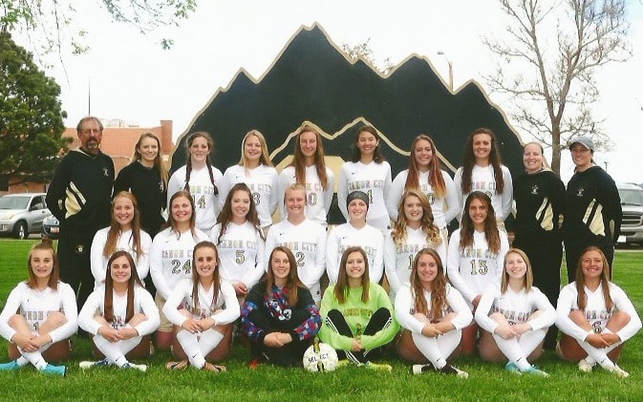 The 2017-18 Cañon City High School Girls Soccer Team.
The 2017-18 Cañon City High School Girls Soccer Team.
Congratulations are due the Cañon City High School girls soccer team. It seems the United Soccer Coaches Organization has recognized them with a 2017-18 High School Team Academic Award. Only 205 squads across the nation earned this honor. Our Lady Tigers compiled a team GPA of 3.86. Though these girls were clearly exemplary in the classroom, they were just as competitive on the soccer pitch, finishing the season with a 10-4-1 record. Congratulations, and thank you for showing us how learning growth matters most, and requires a little risk-taking!
Sandy Smallwood of Lincoln School of Science and Technology deserves a shoutout this week! Sandy displays a constant willingness to share the work she’s doing in Lindamood-Bell interventions. Her advanced knowledge and skill level, which she acquired through positive risk-taking, gives her confidence, allowing her to be comfortable passing what she knows on to others. Because of this, her work is not only benefiting the students she instructs, but her peers as well. Thank you Sandy!
I want to commend Cañon City High School Science Teacher David Laughlin and his students for the amazing field research work they have done studying the impact the Hayden and Cottonwood Creek fires had on the Arkansas River. Last week I had the pleasure of sitting in on a practice presentation of data his class offered, and I was impressed at what they gathered. I look forward to their final product. I commend Mr. Laughlin for taking this risk to endeavor on such a meaningful project-based learning activity with his students.
Sandy Smallwood of Lincoln School of Science and Technology deserves a shoutout this week! Sandy displays a constant willingness to share the work she’s doing in Lindamood-Bell interventions. Her advanced knowledge and skill level, which she acquired through positive risk-taking, gives her confidence, allowing her to be comfortable passing what she knows on to others. Because of this, her work is not only benefiting the students she instructs, but her peers as well. Thank you Sandy!
I want to commend Cañon City High School Science Teacher David Laughlin and his students for the amazing field research work they have done studying the impact the Hayden and Cottonwood Creek fires had on the Arkansas River. Last week I had the pleasure of sitting in on a practice presentation of data his class offered, and I was impressed at what they gathered. I look forward to their final product. I commend Mr. Laughlin for taking this risk to endeavor on such a meaningful project-based learning activity with his students.
On Monday evening, Landon Mascarenaz and Laura Valle-Gutierrez from A+ Colorado shared information with the Cañon City Board of Education about how Cañon City Schools is beating the odds when it comes to academic achievement improvement in Math at the elementary level and in English Language Arts at the middle school level. This represents three consecutive years of strong improvement in these areas, and Mr. Mascarenaz reported that Cañon City was the only school district in Colorado that made two top 10 beating the odds lists,. Kudos to our fine instructional staff at each of these levels for exemplifying our second core belief declaring learning growth matters most, requires risk-taking, and the work we do in our schools has the greatest impact on this.
On a final note, I want to thank Cañon City High School Principal Bill Summers and Regional Intern and Apprentice Coordinator Lisa Tedesko for representing Cañon City Schools so well. They presented at the National Conference on Rural Education about the outstanding work being done here in Fremont County providing real-life work experiences to high school students. Perhaps there is no better way to show how we’re future-focused, believing the development of certain traits and skills will best prepare our students for ever-changing careers.
On a final note, I want to thank Cañon City High School Principal Bill Summers and Regional Intern and Apprentice Coordinator Lisa Tedesko for representing Cañon City Schools so well. They presented at the National Conference on Rural Education about the outstanding work being done here in Fremont County providing real-life work experiences to high school students. Perhaps there is no better way to show how we’re future-focused, believing the development of certain traits and skills will best prepare our students for ever-changing careers.
Our Future Focus
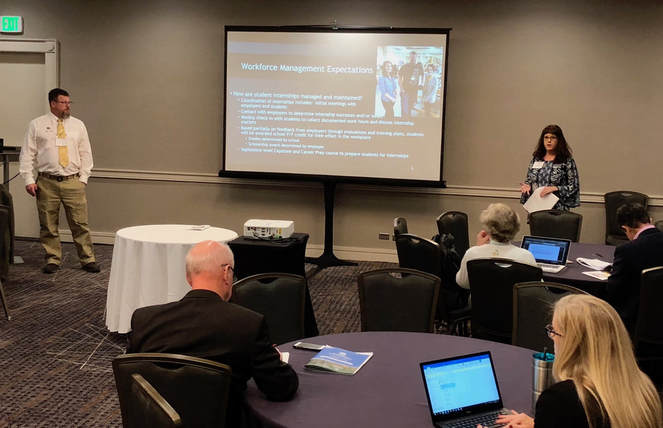 Bill Summers and Lisa Tedesko presented at the National Rural Conference on Education last week in Denver.
Bill Summers and Lisa Tedesko presented at the National Rural Conference on Education last week in Denver.
With the arrival of winter weather we want to remind parents our policy is to allow students to go outside as much as possible during recess time. However, when weather reports indicate outside temperatures will feel less that 20 degrees Fahrenheit, we’ll take action to keep children indoors. One thing parents can do to help us on this front to ensure their children are safe is making sure they are dressed properly for daily weather conditions, including proper shoes, a coat, a hat, and gloves if necessary.
This week Assistant Superintendent of Schools Adam Hartman reminded instructional staff about the importance of creating well-constructed learning targets that align to standards, allow teachers to clearly communicate learning expectations, activate student schema, hold students accountable, and provide a clear lesson focus.
Mr. Hartman says learning targets should always speak to essential knowledge, such as facts, concepts, and generalizations or principles. He describes them as the lesson’s “reason to live”, meaning they must speak to the heart of the learning.
Cañon City Schools uses a WHO/WHAT/HOW learning target construction approach:
This week Assistant Superintendent of Schools Adam Hartman reminded instructional staff about the importance of creating well-constructed learning targets that align to standards, allow teachers to clearly communicate learning expectations, activate student schema, hold students accountable, and provide a clear lesson focus.
Mr. Hartman says learning targets should always speak to essential knowledge, such as facts, concepts, and generalizations or principles. He describes them as the lesson’s “reason to live”, meaning they must speak to the heart of the learning.
Cañon City Schools uses a WHO/WHAT/HOW learning target construction approach:
- Who: Refers to WHO is doing the learning? Uses student-friendly language and ‘I’ or ‘We’.
- What: Refers to WHAT students are required to know and do? They should be aligned to standards, facts, concepts, generalizations, or principles.
- How: This explains HOW they will assess the learning. Try using the phrase “By…” within your learning target and follow it with the actual demonstration of learning expectation. This is not a list of problems from the day’s assignment; rather, it’s a statement about the actual learning. Remember, parents don’t ask their children “What problems did you do at school today?”. They ask “What did you learn at school today?”
Override Progress
This week district middle school level instructional staff began blended learning training through the iLearn Collaborative. Teachers are expected to complete a minimum of 3 and up to 4 online units aimed at growing their knowledge and understanding of how Chromebooks might best be used to support engaging instruction.
Bond Progress
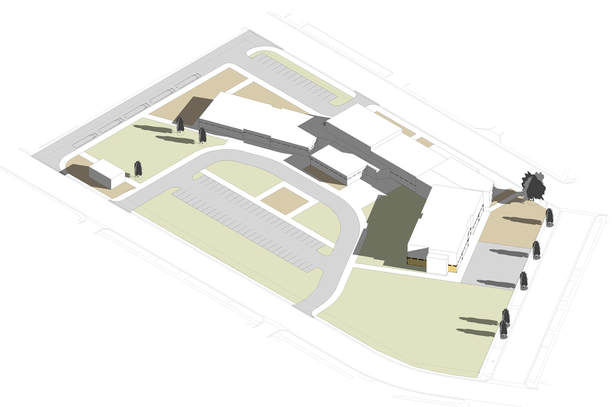 This axonometric render including a 2 story structure on the south end of the campus shows how buildings will shade the campus during the daytime on December 21st each year.
This axonometric render including a 2 story structure on the south end of the campus shows how buildings will shade the campus during the daytime on December 21st each year.
Last Wednesday we held a special web meeting to decide where a new two story structure will be located on the Washington campus. We set a goal to make this decision by the end of the week to allow our architects to proceed with floor plan design work. The major items we took into consideration in making this decision were as follows:
1. What the building will look like when it is approached: The general feeling of the committee has been that most people will first see the facility when they travel north on 9th street toward College. We all agreed a north situated 2-story building would give the facility a better curb look.
2. How the gym and commons can be accessed from the main entry: We agreed each option equally provided a main entry to the outside, a short corridor to access either the gym or the commons, and a way to enter the commons and gym from the east side.
3. To what extent we can bring daylight into the commons: The 2-story north model floorpan had the commons situated where all 4 walls would be covered by other structures. Though our architects indicated they could put in some high windows to let in daylight, it seemed the 2-story south plan would provide more natural light to the commons and ground level views.
4. The size of the available field space for each set of grade levels depending on where the 2-story facility is located: The 2-story south option was much more favorable in this realm, ensuring our older populations have the larger field space situated closer to them.
5. The potential for eventual expansion: If we ever have to expand the school we recognize we are going to have to give up play space no matter which layout we choose. However, the 2-story south option allows much more space with which to do this without further encroaching on our neighbors.
7. The impact winter shadows will have on the site, depending on where the 2 story facility is located: Our architect Doug Abernathy expressed concern about the impact a north 2-story option would have on already limited play space outside that part of the facility. His concern was that the position of the sun at around 8:30 AM on a winter morning would pretty much drench what open field space is available in shade. This caused us to lean more toward the 2-story south option.
After much thought and consideration the decision to go with a 2-story south structure was made.
1. What the building will look like when it is approached: The general feeling of the committee has been that most people will first see the facility when they travel north on 9th street toward College. We all agreed a north situated 2-story building would give the facility a better curb look.
2. How the gym and commons can be accessed from the main entry: We agreed each option equally provided a main entry to the outside, a short corridor to access either the gym or the commons, and a way to enter the commons and gym from the east side.
3. To what extent we can bring daylight into the commons: The 2-story north model floorpan had the commons situated where all 4 walls would be covered by other structures. Though our architects indicated they could put in some high windows to let in daylight, it seemed the 2-story south plan would provide more natural light to the commons and ground level views.
4. The size of the available field space for each set of grade levels depending on where the 2-story facility is located: The 2-story south option was much more favorable in this realm, ensuring our older populations have the larger field space situated closer to them.
5. The potential for eventual expansion: If we ever have to expand the school we recognize we are going to have to give up play space no matter which layout we choose. However, the 2-story south option allows much more space with which to do this without further encroaching on our neighbors.
7. The impact winter shadows will have on the site, depending on where the 2 story facility is located: Our architect Doug Abernathy expressed concern about the impact a north 2-story option would have on already limited play space outside that part of the facility. His concern was that the position of the sun at around 8:30 AM on a winter morning would pretty much drench what open field space is available in shade. This caused us to lean more toward the 2-story south option.
After much thought and consideration the decision to go with a 2-story south structure was made.
Last Week
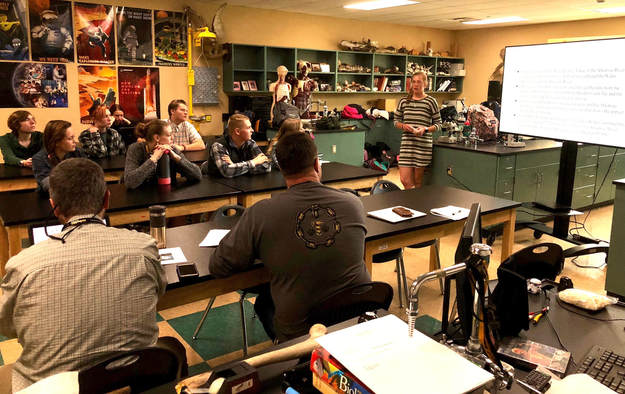 Mr. Laughlin's students are studying the impact the Hayden and Cottonwood Creek fires had on the Arkansas River.
Mr. Laughlin's students are studying the impact the Hayden and Cottonwood Creek fires had on the Arkansas River.
I spent time at my office on Monday catching up on routine correspondence, communicating with a local business regarding a potential cash donation, writing a grant application to the Colorado Education Initiative, and preparing for a board work session and meeting. On Tuesday I attended our monthly touching base meeting with law enforcement, held a Superintendent’s Advisory Council meeting, held an expulsion hearing, met with McKinley leadership about an updated Unified Improvement Plan, held a District Leadership Team meeting, and ended the day in a District Accountability Committee meeting. On Wednesday I began my day touching base with our classified association leaders. I then peeked in on the kickoff of our iLearn blended learning training for middle school staff, attended student presentations in Mr. Laughlin’s CCHS science class, met with Principal Tammy DeWolfe about the future of Lincoln School of Science and Technology, and attended a Washington building design phone meeting. I spent a lot of time on Thursday catching up on correspondence, and was in Denver on Friday at the National Conference on Rural Education to see Lisa Tedesko and Bill Summers present about Cañon City High School’s intern and apprentice program.
This Week
 Officer Canada says, "slow down partner, those roads may be icy out there this morning. Stay at home a little longer and finish that coffee."
Officer Canada says, "slow down partner, those roads may be icy out there this morning. Stay at home a little longer and finish that coffee."
This week's calendar includes a visit from the Williams School District in California. They will be on site in our schools to learn about the success of our Lindamood-Bell early literacy intervention implementation. On Tuesday we have a district office safety team meeting, Superintendent's Advisory Council, and a Cañon City Middle School design team meeting. On Wednesday I'll spend part of the day plans to working on our Management's Discussion and Analysis for our annual audit. This document outlines the way the district views its financial position based on future trends and final audited numbers. I’ll then work on CDE recommended adjustments to our annual Federal Programs Grant. These are due before we receive final approval and can access funds. I hope to finish these Federal Programs revisions on Thursday morning, attend a series of meetings, and then attend to some routine office work I need to complete. On Friday, though we have no school, many CCSD employees will be participating in a district-wide reunification drill. This week I’ll also participate in a pre-screening of paperwork process for the Colorado Association of School Executives Superintendent of the Year award selection committee.
Other Voices
 This is page 1 of the CASB Factual Summary.
This is page 1 of the CASB Factual Summary.
Last week I shared the second in a series of posts aimed at answering the Who, What, Why, and How of Amendment 73. This third installment is aimed at answering the question; who is behind Amendment 73?
I'm doing this because through a resolution in support of Amendment 73 our Board of Education has directed me to distribute factual summaries about the measure to staff and community.
The answer to this week's question is, a coalition of organizations that call themselves Great Schools, Thriving Communities is behind Amendment 73.
If you go to their website at https://www.greatschoolsthrivingcommunities.org/ you'll note their Learn About Us link states:
The 'Vote Yes on Amendment 73' campaign is inspired by a diverse and inclusive coalition of education-connected organizations working to advance better and more equitable funding of public schools through a ballot initiative in 2018.
I'm doing this because through a resolution in support of Amendment 73 our Board of Education has directed me to distribute factual summaries about the measure to staff and community.
The answer to this week's question is, a coalition of organizations that call themselves Great Schools, Thriving Communities is behind Amendment 73.
If you go to their website at https://www.greatschoolsthrivingcommunities.org/ you'll note their Learn About Us link states:
The 'Vote Yes on Amendment 73' campaign is inspired by a diverse and inclusive coalition of education-connected organizations working to advance better and more equitable funding of public schools through a ballot initiative in 2018.
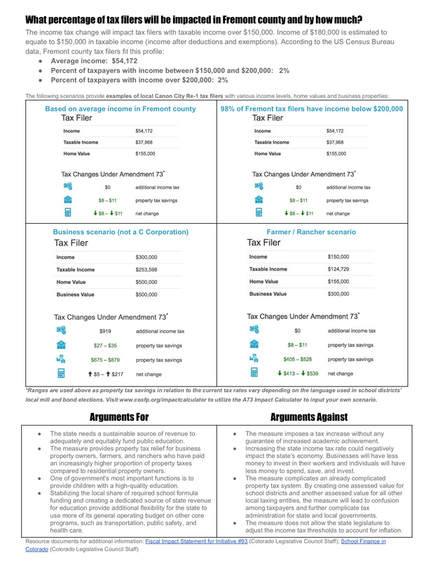 This is page 2 of the CASB Factual Summary.
This is page 2 of the CASB Factual Summary.
'Vote Yes on Amendment 73' believes every student needs the opportunity to reach his or her full potential and to participate meaningfully in the civic and economic life of the community. The Colorado way of life should be about every student having the chance to succeed regardless of their zip code or their learning needs. A strong economy requires quality public education as it develops a quality workforce that will drive a vibrant Colorado economy for decades to come.
The Great Schools, Thriving Communities coalition includes Great Education Colorado, the Colorado Education Association, the Colorado Association of School Executives, and the Colorado Association of School Boards.
These groups and other supporters hold a belief that Colorado's current funding of education at more than $2,000 per student below the national average is having an adverse impact on educational outcomes.
The Great Schools, Thriving Communities Website also has a page that lists quite a few organizations who have endorsed the group's effort. They include among others the Bell Policy Center, Business and Professional Women of Colorado, Colorado AFL-CIO, Colorado Association of Gifted and Talented, the Colorado Association of School Librarians, Colorado BOCES Association, Colorado Children's Campaign, Colorado Council of Churches, Colorado PTA, Colorado Rural Schools Alliance, the League of Women Voters, Rocky Mountain Farmer's Union, Stand for Children, and Taxpayers for Public Education.
One of the key partners in the campaign is the Colorado Association of School Boards. CASB created fact sheets showing how the passage of Amendment 73 would impact each of Colorado's school districts in terms of local taxes, new dollars received, even including how local boards of education have committed to investing new dollars.
I have attached pictures of this two-page document showing the answers to all these questions as they pertain to Cañon City. If you would like to see how Amendment 73 would impact any other school district you can access all of them at this link, as long as you have a Google account: https://drive.google.com/…/1EOuE-rhAoUAE5XLhx2qK15NbRSEAjnek
Last I hear, school districts representing 86% of Colorado school children have passed resolutions in support of Amendment 73, delineating exactly how new funds will be invested.
If you would like to see these resolutions for yourself you can view them at this link: https://drive.google.com/…/1Qtj5y74wt0iUrNV8w-EsBO5fEejDQiv7
Thanks for listening once again!
George S. Welsh
The Great Schools, Thriving Communities coalition includes Great Education Colorado, the Colorado Education Association, the Colorado Association of School Executives, and the Colorado Association of School Boards.
These groups and other supporters hold a belief that Colorado's current funding of education at more than $2,000 per student below the national average is having an adverse impact on educational outcomes.
The Great Schools, Thriving Communities Website also has a page that lists quite a few organizations who have endorsed the group's effort. They include among others the Bell Policy Center, Business and Professional Women of Colorado, Colorado AFL-CIO, Colorado Association of Gifted and Talented, the Colorado Association of School Librarians, Colorado BOCES Association, Colorado Children's Campaign, Colorado Council of Churches, Colorado PTA, Colorado Rural Schools Alliance, the League of Women Voters, Rocky Mountain Farmer's Union, Stand for Children, and Taxpayers for Public Education.
One of the key partners in the campaign is the Colorado Association of School Boards. CASB created fact sheets showing how the passage of Amendment 73 would impact each of Colorado's school districts in terms of local taxes, new dollars received, even including how local boards of education have committed to investing new dollars.
I have attached pictures of this two-page document showing the answers to all these questions as they pertain to Cañon City. If you would like to see how Amendment 73 would impact any other school district you can access all of them at this link, as long as you have a Google account: https://drive.google.com/…/1EOuE-rhAoUAE5XLhx2qK15NbRSEAjnek
Last I hear, school districts representing 86% of Colorado school children have passed resolutions in support of Amendment 73, delineating exactly how new funds will be invested.
If you would like to see these resolutions for yourself you can view them at this link: https://drive.google.com/…/1Qtj5y74wt0iUrNV8w-EsBO5fEejDQiv7
Thanks for listening once again!
George S. Welsh
